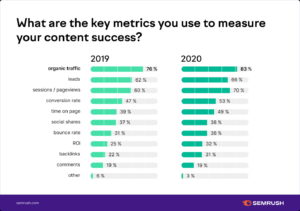Content marketing is used by 91% of B2B marketers and 86% of B2C marketers because it is one of the most effective ways to generate traffic and leads. But only a few know what is content analysis and how it fits in their content marketing strategy. You have to have a robust content marketing and content analysis strategy to make it work.
Content analysis is a crucial part of a great content marketing strategy. Often overlooked, the content analysis doesn’t get the importance it deserves. However, when done appropriately, it helps you better understand your content and how effectively it meets your content marketing and marketing objectives.
What is Content Analysis?
Content analysis is a technique used to critically analyze content to measure its performance. The content performance is analyzed based on certain criteria (known as qualities) such as relevance, SEO, accuracy, consistency, etc. The content analysis is used for decision-making.
Marketers use content analysis to see if the content is achieving its objective and delivering the same message as intended. If you’ll forget about your content once it has been published, you’ll never have any idea of how well it is performing and what message it is delivering.
Targeting keywords isn’t just enough.
The content must integrate with your business strategy, vision, and marketing strategy. A misalignment can turn out to be very problematic as it ruins conversions and revenue throughout the funnel.
Content Analysis Benefits
Content analysis has several benefits both in the short-run and long-run. The leading ones are covered below to give you an idea of why it must be a part of your content marketing strategy:
Understand Metrics
The content analysis helps measure content performance. In fact, one of the primary reasons why marketers do content analysis is to measure content performance. Here is a list of key metrics that marketers use to measure content success:

You can measure these metrics easily via your analytics tool but your analytics tool won’t tell you why your content is underperforming on a specific metric (e.g. social shares). This is where the content analysis will help you.
It helps you dig deep and understand why your content isn’t working.
For example, if your blog posts don’t get a lot of social shares, in-depth content analysis will identify reasons. Let’s assume analysis shows that your blog posts have poor titles that aren’t social media-friendly.
Based on the findings of the content analysis, you can work on titles. This is how content analysis helps you better understand metrics and improve performance.
Content Planning
Content planning is a continuous process. You need to keep your editorial calendar filled so that the content team knows what type of content they have to write and publish. The content analysis helps you identify top-performing content and underperforming content. This data is helpful in content planning.
The formula is simple: Do more of what’s working for your business.
If a certain content type has a significantly high conversion rate and ROI (e.g. infographics), you can start producing more infographics. Similarly, you can identify topics, keywords, post length, and formatting that work best for your target audience.
Content Repurposing
Content repurposing must be an essential part of your content strategy as it helps you improve content visibility and reach more target audience. In the absence of content analysis, selecting the right content pieces to repurpose becomes an overwhelming task.
You can’t pick blog posts based on judgment and repurpose them. Rather these must be selected on the basis of data. For example, if a blog post has performed exceptionally well in SERPs, you can consider repurposing it to reach a wider audience.
The content analysis does this automatically for you. Finding the best content to repurpose is just a by-product (yet very important one) of content analysis.
Optimization
The content analysis helps you optimize content in several ways including:
- On-page and technical SEO glitches
- It helps you identify broken links
- You can find obsolete content
- Brand inconsistency
- Internal links to dead pages or 404 pages.
These issues are, otherwise, go unnoticed and content analysis seems to be the only way to identify and fix them. For example, if you have articles that link to a product that you don’t sell anymore, these CTAs can only be identified during content analysis.
How to Do Content Analysis
There isn’t any single best way to perform content analysis. You can choose to do it manually by inspecting each content piece for a set criterion. Or, you can use a content analysis tool that will help you identify key issues throughout your website.
Both have their unique pros and cons. Let’s see what works best and why:
Manual Content Analysis
It is a good idea to analyze content manually if you have a small blog with minimal content. You can create an Excel sheet like this:
Add more columns based on your requirements. Visit each article manually and inspect it for all the qualities. This is a simple yet flexible process that doesn’t cost you a lot of money. Your content team or even a single individual can do it.
However, it can turn out to be a time-consuming process if you have a large blog with lots of content.
Content Analysis Tools
Several tools help you in content analysis such as Ahrefs, SEMrush, Moz, Google Search Console, etc. These tools automatically scan and audit your website and report SEO, technical, and health-related issues.
However, tools won’t be able to find obsolete content, inaccuracies, weak CTAs, etc. You’ll still have to quickly scan the results generated by the tool. Content analysis tools work best for large websites that produce a lot of content in different formats that are hard to analyze manually.
Conclusion
If you create and publish content, you need to make sure you analyze your content regularly. It is a good practice to perform content analysis twice a year. It doesn’t matter how you do it (manual vs. automated), both works great. If you can afford it, use a tool for assistance but don’t rely on it completely. There are a lot of issues that content analysis tools won’t detect.
The decisions that you take based on content analysis are more important than anything else. Don’t waste your analysis by not taking appropriate steps to improve content throughout the funnel.
Featured Image: Unsplash






